What to know about the drug xylazine and why it's making fentanyl worse
Xylazine is making fentanyl "even deadlier," according to DEA.
The Drug Enforcement Administration is warning that a powerful veterinary sedative is being combined illicitly with fentanyl, making it even more dangerous.
DEA issued a public safety alert about the widespread threat posed by a mixture of a non-opioid animal sedative called xylazine, also known as "Tranq," and fentanyl. There has been a sharp increase in the trafficking of the drug combination, according to DEA.

The fentanyl-xylazine mix has been found in 48 states, according to DEA Administrator Anne Milgram.
"Xylazine is making the deadliest drug threat our country has ever faced, fentanyl, even deadlier," Milgram said. "DEA has seized xylazine and fentanyl mixtures in 48 of 50 States. The DEA Laboratory System is reporting that in 2022 approximately 23% of fentanyl powder and 7% of fentanyl pills seized by the DEA contained xylazine."
Xylazine is a powerful sedative approved by the Food and Drug Administration in 1972 for veterinary use, but it is not approved for use in humans.
Users of the mixture can be at higher risk for deadly overdose because unlike fentanyl, xylazine is not an opioid, and so the common opioid overdose treatment naloxone (Narcan) is not known to be effective in reversing its effects, according to the federal government.

In addition to the risk of increased risk of death posed by xylazine, "people who inject drug mixtures containing xylazine also can develop severe wounds, including necrosis -- the rotting of human tissue -- that may lead to amputation," the DEA said in a statement.
Xylazine is not readily detected by routine toxicology screening, making exposure to the drug difficult to diagnose, according to an FDA warning to stakeholders in the health care community last November.
Since 2020, drug overdoses have been linked to more than 100,000 deaths annually in the U.S., about two-thirds of which are fentanyl-related




